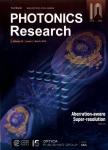Characterizing bubble interaction effects in synchronous-double-pulse laser ablation for enhanced nanoparticle synthesis
作者机构:Chair of Materials Science and Additive ManufacturingSchool of Mechanical Engineering and Safety EngineeringUniversity of Wuppertal42119 WuppertalGermany Chair of Aerodynamics and Fluid MechanicsSchool of Engineering and DesignTechnical University of Munich85748 Garching bei MünchenGermany Munich Institute of Integrated MaterialsEnergyand Process Engineering(MEP)Technical University of Munich85748 Garching bei MünchenGermany Technical Chemistry I and Center for Nanointegration Duisburg-Essen(CENIDE)University of Duisburg-Essen45141 EssenGermany
出 版 物:《Photonics Research》 (光子学研究(英文版))
年 卷 期:2023年第11卷第12期
页 面:2054-2071页
核心收录:
学科分类:080901[工学-物理电子学] 0809[工学-电子科学与技术(可授工学、理学学位)] 07[理学] 08[工学] 070205[理学-凝聚态物理] 0817[工学-化学工程与技术] 080103[工学-流体力学] 0807[工学-动力工程及工程热物理] 080401[工学-精密仪器及机械] 0804[工学-仪器科学与技术] 080501[工学-材料物理与化学] 0805[工学-材料科学与工程(可授工学、理学学位)] 0703[理学-化学] 0803[工学-光学工程] 0702[理学-物理学] 0801[工学-力学(可授工学、理学学位)]
基 金:Deutsche Forschungsgemeinschaft(GO 2566/8-1 GO 2566/14-1 AD 186/38-1 428315411 INST 20876/212-1 GO 2566/10-1 445127149)
主 题:interaction synthesis bubble
摘 要:To further advance nanomaterial applications and reduce waste production during synthesis,greener and sustainable production methods are *** laser ablation in liquid(PLAL)is a green technique that enables the synthesis of *** study uses synchronous-double-pulse PLAL to understand bubble interaction effects on the nanoparticle *** adjusting the lateral separation of the pulses relative to the maximum bubble size,an inter-pulse separation is identified where the nanoparticle size is *** cavitation bubble pair interaction is recorded using a unique coaxial diffuse shadowgraphy *** system allows us to record the bubble pair interaction from the top and side,enabling the identification of the bubble’s morphology,lifetime,volumetric,and displacement *** is found that the collision and collapse of the bubbles generated at a certain inter-pulse separation results in a larger nanoparticle *** results mark a significant advancement by controlling the abundance of larger nanoparticles in PLAL,where previous efforts were primarily focused on reducing the average nanoparticle *** experimentally observed trends are confirmed by numerical simulations with high spatial and temporal *** study serves as a starting point to bridge the gap between upscaled multi-bubble practices and fundamental knowledge concerning the determinants that define the final nanoparticle size.



